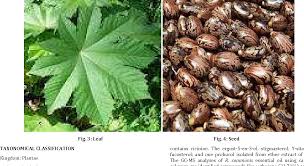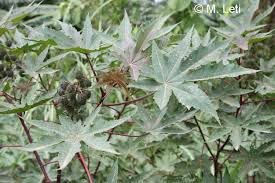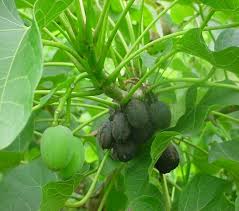Ricinus communis Linn.
| Botanical Name | Ricinus communis Linn. |
| Order: | Malpighiales |
| Family: | Euphorbiaceae |
| Genus: | Ricinus |
| Species: | R. communis |
| Common Names: | Castor bean, Castor oil plant |
Plant Synonyms
Plant Local Names
Yoruba Name: Ilara
Igbo Name: Ogili isi
Plant Habitat
Plant Material of Interest
Seed, leaf stem and root or whole plant.
Plant Description
Coarse perennial, 10- 13m tall in the tropics, with the stem 7.5- 15cm in diameter, but usually behaves as an annual in the temperate regions 1- 3m tall; stems succulent, herbaceous, very variable in all aspects; leaves alternate, orbicular, palmately compound, 1- 6dm broad, with 6- 11toothed lobes, glabrous; flowers numerous in long inflorescences, with male flowers at the base and female flowers at the tips; petals absent in both sexes, sepals 3- 5, greenish; stamens numerous, 5- 10mm long; ovary superior, 3-called with a short style and 3 stigmas; fruit a blobosely capsule 2.5cm in diameter, on an elongated pedicel, usually spiny, green turning brown on ripening, indehiscent in modern cultivars, usually containing 3 seeds; seeds ovoid, tick-like, shiny, 0.5- 1.5 cm long, carunculate, vari-colour with base colour white, grey, brownish, yellow, brown, red, or black, with the outer pattern grey or brown to black splotches, poisonous and allergenic, possibly fatal, from 1,000 to 11,000 per kg, commercial varieties having 2200 to 3200 per kg (Reed, 1976).
Plant Used Parts
Plant Uses
i. Oil used in coating fabrics and protective covering in manufacture of high grade lubricants, transparent typewriter and printing inks, in textile dyeing.
ii. One seed swallowed as oral contraceptive, effective for one year, single seed per year taken orally for five consecutive years to achieve permanent contraception or sterilization (Ogbochukwu, 2005.)
Plant Therapeutic Action
Plant Precaution for Use
Plant Adverse Effect
Plant Contraindication
Plant Dosage Forms
Plant Dosage
Plant Storage
Plant Chromatographic Fingerprint
Plant Constituents
The most popular part of Ricinus communis plant is the seed. The undecorticated seeds usually contain from 40- 53% of oil (Trease and Evans; 1989) but may be as high as 58- 60%. The endosperm contains two sulphydryl dependent amino peptidases. The oil contains glycerides of ricinoleic acids; isoricinoleic, stearic and dihydrostearic acids. (Trease and Evans; 1989). It also contains lipases and a crystalline alkaloid called ricinine. The seed also contains ricins.
RICININE
Ricinine is a heterocyclic (neutral) alkaloid structurally related to nicotinamide. It is in the pyridine chemical class. Ricinine is structurally related to piperine from piper spp (Piperaceae). (Trease and Evans; 1989) Ricinine is known chemically as nicotinonitrile 1,2-dihydro-4-methoxy-1-methyl-2-oxo-ricinine. (Ogabidu, 1991.)


